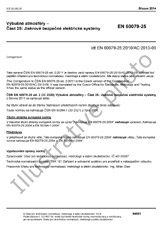We need your consent to use the individual data so that you can see information about your interests, among other things. Click "OK" to give your consent.

IEEE 1932.1-2024
IEEE Standard for Licensed/Unlicensed Spectrum Interoperability in Wireless Mobile Networks
Translate name
STANDARD published on 15.7.2024
The information about the standard:
Designation standards: IEEE 1932.1-2024
Publication date standards: 15.7.2024
SKU: NS-1189478
The number of pages: 78
Approximate weight : 234 g (0.52 lbs)
Country: International technical standard
Category: Technical standards IEEE
Annotation of standard text IEEE 1932.1-2024 :
New IEEE Standard - Active.
The proliferation of connected users and downloaded applications has driven the development of a new paradigm in wireless mobile networks. Additional air interfaces operating in the unlicensed spectrum serving as supplementary downlinks (SDL) and enhancing end-user throughput are utilized by this paradigm. However, integrating these interfaces into licensed base stations can be challenging, as they are distributed across various domains. WiFi is a key technology for increasing capacity through the user plane interface. Traffic is buffered in WiFi when unlicensed channels become unavailable, and transmissions resume once new radio slots are free. To meet the strict round-time delay requirements of fifth generation (5G) networks, a new virtual controller that resides at the mobile edge cloud is defined in this standard. The multi-connectivity model and traffic sharing between licensed and unlicensed interfaces are coordinated by the controller based on the real-time availability of unlicensed channels for specific user equipment.Two schemes are presented for managing multi-connectivity modes: distributed and centralized. In the distributed scheme, traffic forwarding and steering between distributed radio interfaces across domain sites is managed by the controller. In the centralized scheme, various radio interfaces are co?located in the same base station, and traffic steering is managed by the controller through a new unified 5G media access control (MAC) design. Traffic sharing between different interfaces is ensured by the controller, given that access to operator-deployed WiFis or any other customer WiFi using separate service level agreements (SLAs) is provided by operators. Multi-connectivity modes imply the provision of efficient new services that may require measuring airtime for each interface and changes to user plane topology.
ISBN: 979-8-8557-0545-4, 979-8-8557-0546-1
Number of Pages: 78
Product Code: STD26797, STDPD26797
Keywords: 5G core, IEEE 1932.1, licensed band, spectrum utilization, unlicensed band, virtual controller
Category: Communication Networks/Systems
We recommend:
Updating of laws
Do you want to be sure about the validity of used regulations?
We offer you a solution so that you could use valid and updated legislative regulations.
Would you like to get more information? Look at this page.



 Cookies
Cookies
